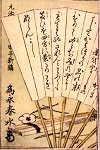
|
|
|
|
|
 |
 |
 |
 |
 |
 |
|
|
|
Industrial Beginnings The young Meiji government worked hard to balance production for domestic use as well as for export. Protection for native industries was a prime consideration, but the new internationalists understood the necessity for an accelerated industrial revolution in Japan. They were quick to adopt western methods in heavy industries and in the processing of textiles. The foundations for some of the great fortunes of Japan were laid in the early Meiji period, when the government, after nationalizing and developing such industries as shipbuilding, mining, railroads, electricity and silk and cotton mills, sold them to merchant contractors (sei- sho), who operated them as independent enterprises. This was the beginning of the Mitsubishi, Mitsui and Sumitomo fortunes and the birth of the great Zaibatsu organizations. The development of these corporations into powerful industrial combines was based upon tight family control, the general economic growth of the country and the demand for consumer goods when a wave of prosperity came to Japan after the war with China. The war, while not entirely successful, opened new markets for Japan in Formosa and Mongolia. A few years later, the war with Russia, which was a success, brought additional markets. As these areas were opened to Japanese goods, domestic markets increased. By 1905, Japan was able to compete successfully with western goods in many Asian markets.
|
